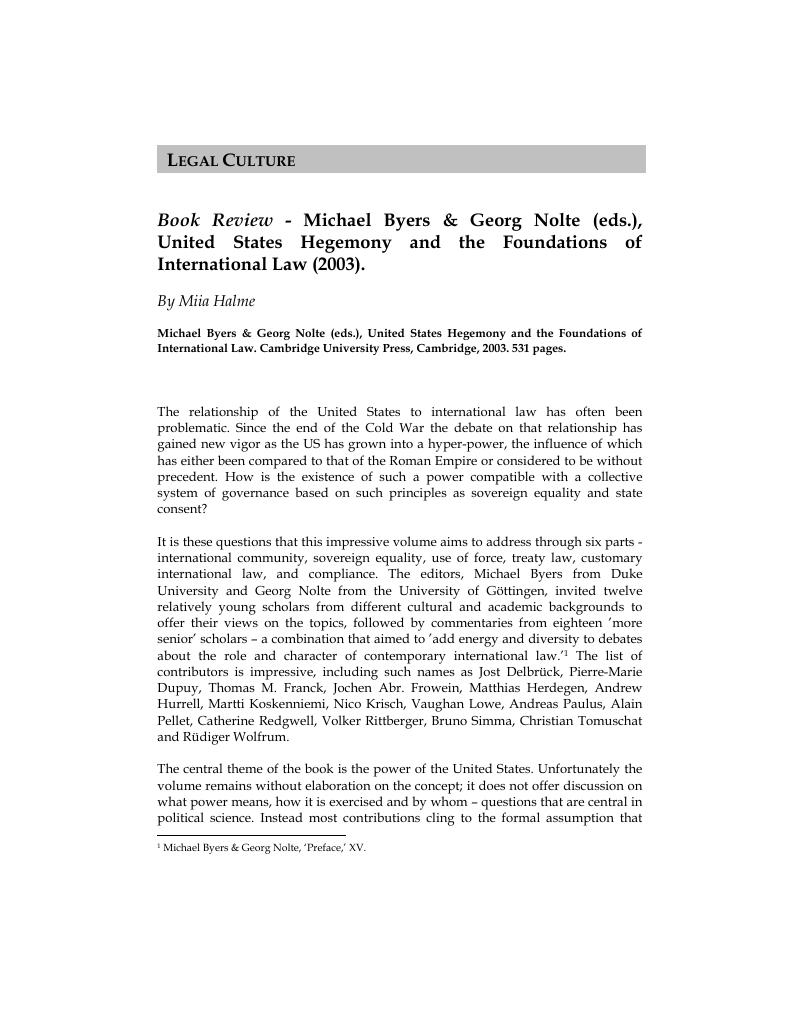Article contents
Michael Byers & Georg Nolte (eds.), United States Hegemony and the Foundations of International Law (2003) - Michael Byers & Georg Nolte (eds.), United States Hegemony and the Foundations of International Law. Cambridge University Press, Cambridge, 2003. 531 pages.
Published online by Cambridge University Press: 06 March 2019
Abstract

- Type
- Legal Culture
- Information
- Copyright
- Copyright © 2003 by German Law Journal GbR
References
1 Byers, Michael & Nolte, Georg, ‘Preface,’ XV.Google Scholar
2 Grewe, Wilhelm G., Epochen der Völkerrechtsgeschichten, Nomos, (1984); Heinrich Triepel, Die Hegemonie -Ein Buch von führenden Staaten, (1938). See Georg Nolte, ‘Conclusions, 497.Google Scholar
3 Thanks for Jarna Petman, present in Göttingen, for a discussion on the seminar.Google Scholar
4 Kohen, Marcelo G., ‘The use of force by the United States after the end of the Cold War, and its impact on international law,’ 197-231; Thomas M. Franck, ‘Commentary,’ 264-274. The second half of Thomas Franck's commentary was published as an editorial comment in the American Journal of International Law, defending US use of force in Afghanistan as self-defence. See Thomas M. Franck, ‘Terrorism and the Right of Self-Defence’ (2001) 95(3) AJIL 893.Google Scholar
5 Krisch, Nico, ‘More equal than the rest? Hierarchy, equality and US predominance in international law,’ 135-175.Google Scholar
6 Klein, Pierre, ‘The effects of US predominance on the elaboration of treaty regimes and on the evolution of the law of treaties,’ 363-391.Google Scholar
7 Cosnard, Michel, ‘Sovereign Equality – ‘The Wimbledon sails on,’ 117-134, at 124 and 125-6.Google Scholar
8 Krisch (note 5), 135-175.Google Scholar
9 Rousseau, Jean-Jacques, The Social Contract, (1762), ch III: ‘The Right of the Strongest.’ Quoted in Kohen (note 3), 229.Google Scholar
10 Kohen (note 4), 229.Google Scholar
11 Kwakwa, Edward, ‘The international community, international law, and the United States: three in one, two against one, or one and the same?’ 25-56, especially 51.Google Scholar
12 Andreas Paulus, ‘The influence of the United States on the concept of the ‘International Community', 57-90, 89.Google Scholar
13 Martti Koskenniemi, ‘Comments on chapters 1 and 2,’ 98.Google Scholar
14 Kwakwa (note 11), 26.Google Scholar
15 Cosnard (note 7), 134.Google Scholar
16 Ratner, Stephen, ‘Comments on Chapters 2 and 3', in particular 101-104.Google Scholar
17 Nolte (note 2), 492.Google Scholar
18 Krisch (note 5), 172.Google Scholar
19 Lowe, Vaughan, ‘Comments to Chapters 16 and 17,’ 477.Google Scholar
20 Hardt, Michael and Negri, Antonio, Empire, Harvard University Press, (2000).Google Scholar
21 Koskenniemi (note 13), 99.Google Scholar
22 Id., 100.Google Scholar
23 Byers & Nolte XV, (note 1).Google Scholar
24 Cosnard (note 7), 131-2. For a discussion on the relationship of the international community and the US, see Kwakwa, (note 11), and Paulus, (note 12).Google Scholar
25 Carr, E.H., The Twenty Years Crisis, 2nd edition, Macmillan, (1946), 86.Google Scholar
- 1
- Cited by




